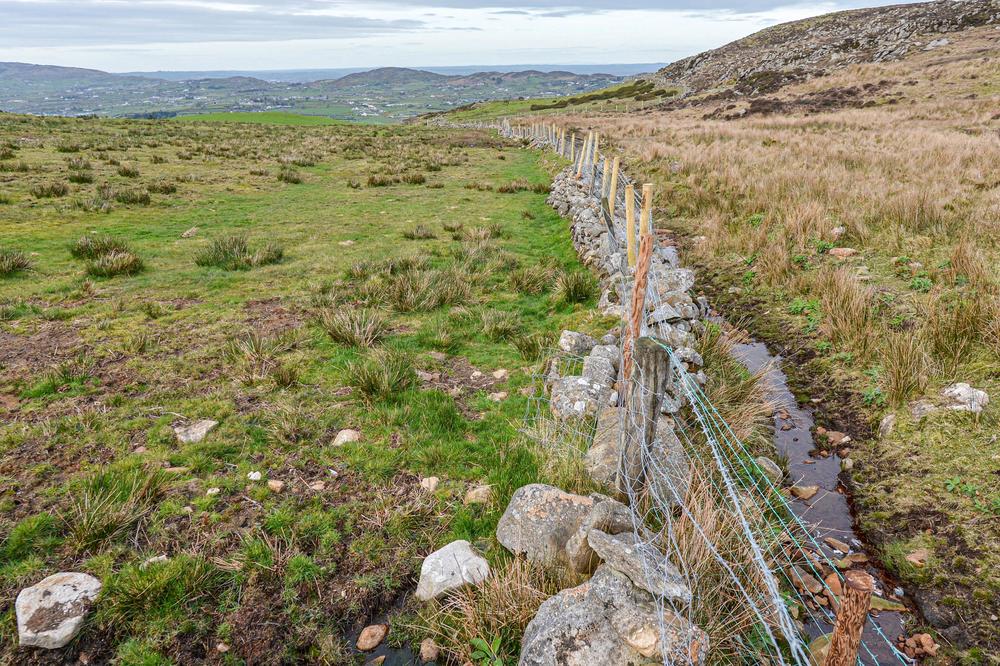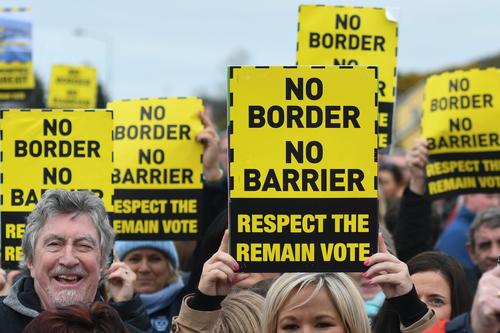Like an Open Wound
The British Parliament passed the Government of Ireland Act 100 years ago, leading to the partition of Ireland after the War of Independence
Feb 17, 2021
The border (seen here near Jonesborough in Northern Ireland’s County Armagh), between the Republic of Ireland and Northern Ireland, which is part of the United Kingdom, marks the external border of the European Union as of January 1, 2021.
Image Credit: Picture Alliance/NurPhoto/Artur Widak
In Northern Ireland, preparations for commemorating the 100th anniversary of the partition of Ireland have long been underway. The Protestant Orange Order is planning fireworks and a march in late May to commemorate the first session of the Northern Irish Parliament in June 1921, and the Conservative government of British Prime Minister Boris Johnson plans to hold a memorial ceremony at Belfast City Hall.
The planning is not only being made more difficult by the coronavirus pandemic, but also by the long-term consequences of partition. Nationalists, who are in favor of a united Ireland, do not want to take part in celebrations, and unionists who want Northern Ireland to remain in the UK are annoyed by this boycott, a reminder that the wounds of history have not healed.
Above all, the continuing uncertainty in relation to Brexit looms over the planning. It is still unclear whether the UK’s exit from the European Union will ultimately lead to a new hard border between the two parts of the island of Ireland, i.e., between the Republic of Ireland and Northern Ireland, which forms part of the United Kingdom. The transition phase ended on December 31, 2020.
Government of Ireland Act
On December 23, 1920, the British Parliament passed the Government of Ireland Act, which came into force in May 1921 and was supposed to enable self-government for all of Ireland under British control. However, only six counties, in the province of Ulster, remained in the United Kingdom as the Republic of Northern Ireland. The rest of the country became a sovereign state after the War of Independence in 1921 and in 1949 became the Republic of Ireland.
Professor Arnd Bauerkämper, a historian at the Friedrich Meinecke Institute at Freie Universität, sees the reasons for the partition of Ireland in an unresolved conflict that goes back to the early modern period. He explains, “First there was the seizure of land by the British, especially in the north part of Ireland, which the rural and Catholic population increasingly opposed from the 19th century. In addition, there is a denominational conflict between Protestants and Catholics that has existed since the 17th century.” During the 19th and early 20th centuries, this resulted in increasing radicalization on both sides, culminating in the 1916 Easter Rising, also referred to as the Easter Rebellion, which the British military ended in a bloody confrontation.
In March 2019, citizens of the Northern Irish counties bordering on the Republic of Ireland protested in Carrickcarnon against drastic changes in the course of the Brexit negotiations between the United Kingdom (UK) and the European Union.
Image Credit: Picture Alliance/NurPhoto/Artur Widak
Decades of Bloody Conflicts
The conflict over Northern Ireland continued after the island was legally divided. “The partition was a compromise that was ultimately not respected by either side,” says Bauerkämper. “The new Irish Republic was missing part of the land, and the situation was also unsatisfactory for the supporters of the Union.”
Decades of bloody confrontation followed, culminating in the “Troubles” of the 1970s and 1980s, with paramilitaries fighting on both sides. The involvement of the British Army and Northern Irish police intensified the conflict. The death toll is estimated at more than 3,500. Finally, in 1998 a compromise was sealed in the Good Friday Agreement, and the division of power in Northern Ireland was institutionalized.
Since then, the island has been pacified, but not everyone has made their peace with the partition. This is apparent in the dispute over the official commemoration. Historian Bauerkämper points out, “The struggle for memory continues on both sides. The use of stories still plays a major role today.”
Brexit Complicates the Situation
The situation is not made any easier by the fact that nearly one hundred years after the partition, the status of Northern Ireland suddenly became an issue of global political importance – or rather, a stubborn stumbling block in the Brexit negotiations between the United Kingdom and the European Union (EU).
“The issue of Northern Ireland made the exit negotiations extremely difficult,” says Professor Tanja Börzel, director of the Berlin Center for European Integration at the Otto Suhr Institute of Political Science at Freie Universität Berlin. Questions surrounding the border between the Republic of Ireland and Northern Ireland have once again surfaced due to the United Kingdom leaving the European single market. To avoid the risk of endangering the fragile coexistence of the two parts of the island of Ireland, the customs borders for goods coming from Great Britain are currently located at the sea ports in Northern Ireland. Some view this as amounting to a new internal border between Northern Ireland and Great Britain.
This complicated issue led to Northern Ireland being “instrumentalized to a certain extent” by both sides in the negotiations, says Börzel. Of course, there is genuine concern that “Brexit will endanger what has been achieved in the region during the past few decades,” she says. For Northern Ireland, European integration means not only the dismantling of borders and border controls, but also extensive EU funding. Both are up for grabs with Brexit.
The complexities increased after the Democrats’ victory in the U.S. presidential election, not only because of Joe Biden’s Irish roots. He and his party made it clear early on that they would not consider a trade deal with the United Kingdom that would jeopardize the Good Friday Agreement.
Political scientist Tanja Börzel pointed out that this brought movement back into the Brexit negotiations. It remains to be seen whether Ireland can be spared a new division, 100 years after partition and 22 years after reconciliation through the Good Friday Agreement.
This text originally appeared in German on December 5, 2020, in the Tagesspiegel newspaper supplement published by Freie Universität. Several passages were updated for this version.
Further Information
- Prof. Dr. Arnd Bauerkämper, Freie Universität Berlin, Friedrich Meinecke Institute of History, Email: baue@zedat.fu-berlin.de
- Prof. Dr. Tanja Börzel, Director of the Berlin Center for European Integration, Freie Universität Berlin, Otto Suhr Institute of Political Science, Email: europe[at]zedat.fu-berlin.de


